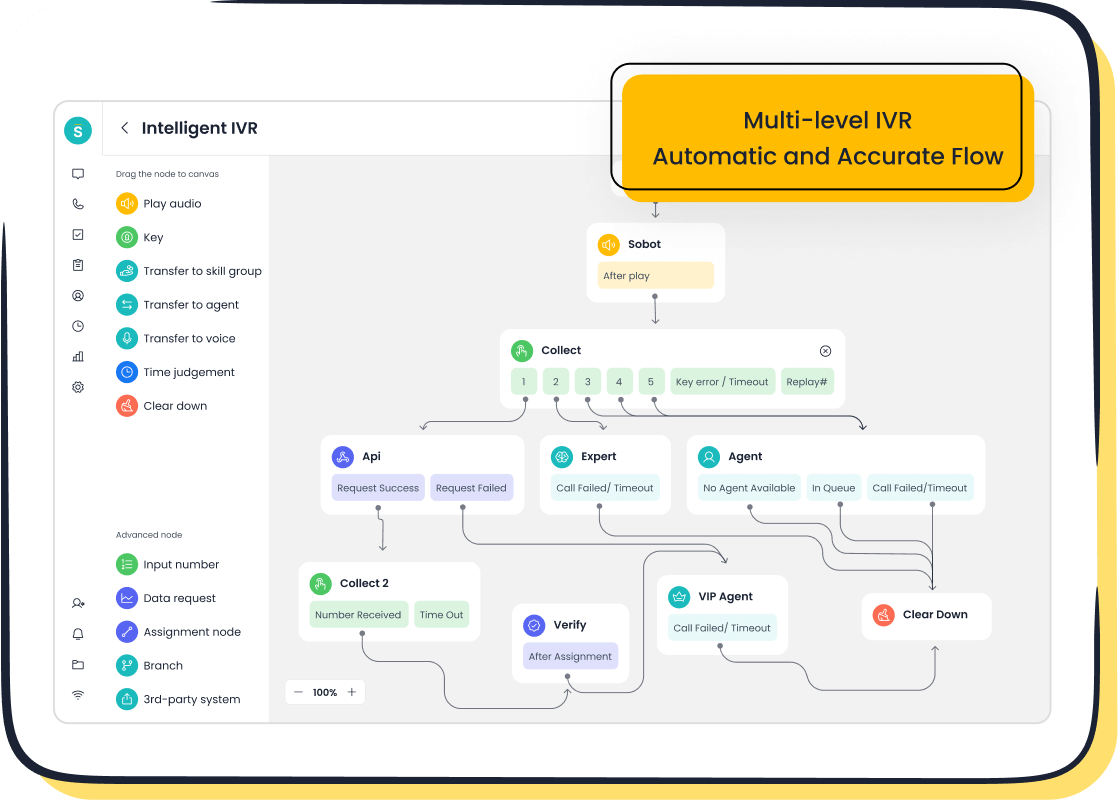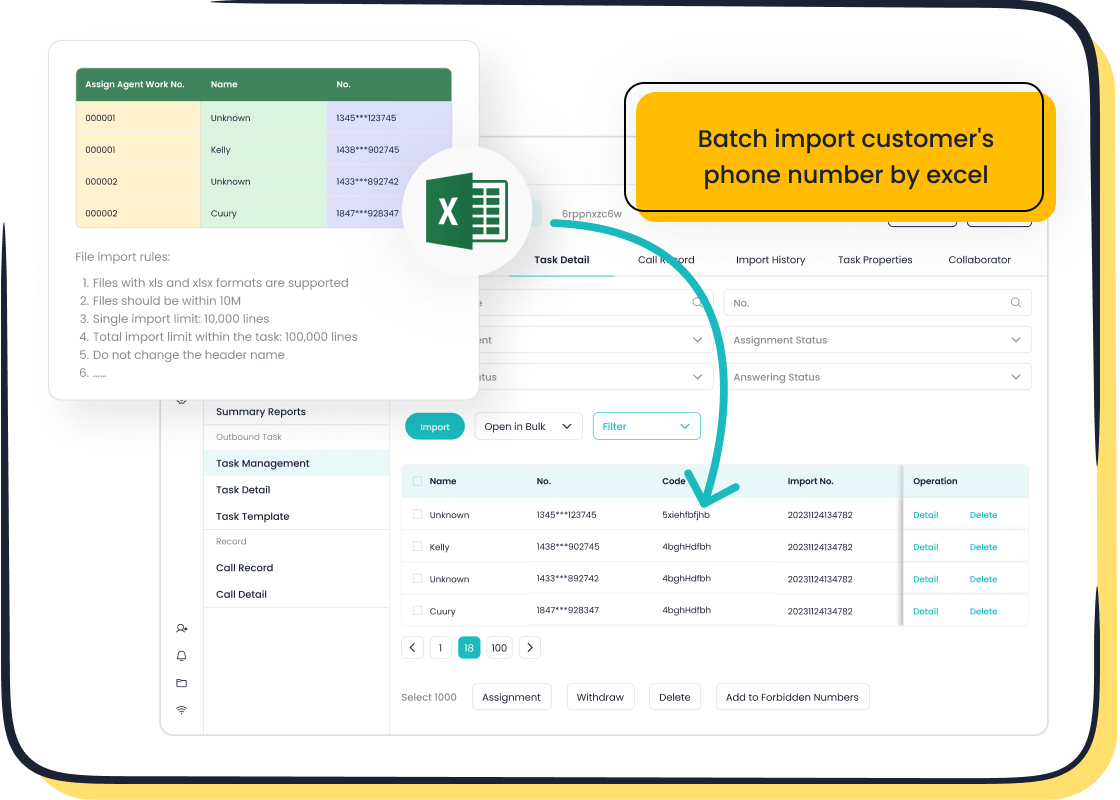Top Strategies to Improve Service Level in Contact Centers

Service level (SL) plays a vital role in shaping customer satisfaction and ensuring operational success in contact centers. Customers today expect swift responses, with studies showing that faster response times directly enhance satisfaction. For instance:
- A 5% increase in customer retention can boost profits by 25%.
- 83% of consumers prefer businesses to proactively address issues before they arise.
Operational success also hinges on SL metrics like Average Speed of Answer (ASA) and Call Abandonment Rate. Tools like Sobot’s Voice/Call Center help businesses meet these benchmarks, ensuring efficiency and customer loyalty.
Understanding Service Level (SL) and Its Importance
What Is Service Level (SL)?
Definition and explanation of service level as a key performance metric.
Service level (SL) is a critical metric in contact center operations. It measures the percentage of customer calls answered within a specific time frame. For example, if your contact center has a target of answering 80% of calls within 20 seconds, this becomes your SL benchmark. This metric reflects how responsive your team is to customer inquiries.

SL is not just a number; it represents your ability to meet customer expectations. A high SL indicates that your team consistently delivers timely responses, which directly impacts customer satisfaction. Tools like Sobot’s Voice/Call Center help you monitor and improve SL by providing real-time data and intelligent call routing.
Common standards for SL, such as the 80/20 rule.
The 80/20 rule is a widely accepted standard in the industry. It means answering 80% of calls within 20 seconds. This benchmark ensures a balance between operational efficiency and customer experience. However, your SL target may vary depending on your industry and customer needs. For instance, financial services often aim for higher SLs due to the urgency of customer inquiries.
Why Service Level Matters
Impact of SL on customer satisfaction and loyalty.
A high SL directly influences customer satisfaction. When customers receive prompt responses, they feel valued and are more likely to remain loyal to your brand. Studies show that 86% of customers are willing to pay more for a better experience. By maintaining a strong SL, you not only meet expectations but also build trust and long-term relationships.
Role of SL in improving call center efficiency and reducing costs.
SL also plays a vital role in operational efficiency. Metrics like Average Speed of Answer (ASA) and Average Handle Time (AHT) help you evaluate and optimize your processes. For example:
| Metric | Description |
|---|---|
| Service Level | Measures the percentage of calls answered within a specific time frame, indicating responsiveness. |
| Average Speed of Answer (ASA) | Indicates the average time taken to answer calls, reflecting efficiency in handling customer inquiries. |
| Average Handle Time (AHT) | Represents the average duration of customer interactions, including talk and hold times, impacting customer satisfaction. |
By analyzing these metrics, you can identify bottlenecks and streamline workflows. Sobot’s Voice/Call Center offers features like real-time monitoring and AI-powered call routing, enabling you to reduce SLA response time and improve overall efficiency.
Key Metrics to Measure and Improve SLA Response Time
First Response Time (FRT)
Definition and its significance in meeting SLAs.
First Response Time (FRT) measures the time it takes for your team to respond to a customer’s initial inquiry. It is a critical response time metric that reflects how quickly you acknowledge customer concerns. A low FRT demonstrates your commitment to resolving issues promptly, which is essential for meeting service level agreements (SLAs). For example, if your SLA requires a response within 30 seconds, maintaining a low FRT ensures compliance and builds trust with your customers.
How FRT influences customer satisfaction and SL.
FRT directly impacts customer satisfaction and service level (SL). Customers value quick responses, and a low FRT can enhance their experience. Studies show that 82% of customers expect an immediate reply when contacting a business. By reducing FRT, you not only improve SLA response time but also increase first-time resolution rates, leading to higher customer loyalty. Tools like Sobot’s Voice/Call Center help you monitor FRT in real-time, enabling faster responses and better SL performance.
Average Speed of Answer (ASA)
Explanation of ASA and its impact on SLA response time.
Average Speed of Answer (ASA) measures the average time it takes for an agent to answer incoming calls. This metric plays a significant role in improving SLA response time. A lower ASA indicates that your team is efficiently handling customer inquiries, reducing wait times and enhancing the overall experience. For instance, an ASA of 10 seconds is far more effective than one exceeding 30 seconds, as it minimizes customer frustration.
Tips for reducing ASA to improve SL.

To reduce ASA, focus on optimizing your workforce and leveraging technology. Accurate forecasting and scheduling ensure you have enough agents during peak hours. Implementing smart call routing, like the AI-powered features in Sobot’s Voice/Call Center, directs calls to the most suitable agents, cutting down response times. Additionally, training agents to handle calls efficiently can further lower ASA and improve SLA response time.
Abandonment Rate
Definition and its relationship to SL.
Abandonment rate measures the percentage of calls disconnected by customers before reaching an agent. It is calculated by dividing the difference between calls received and calls handled by calls received, then multiplying by 100. A high abandonment rate negatively affects SL, as it indicates unmet customer needs. Monitoring this metric helps you identify when additional resources are required to meet demand.
Strategies to minimize abandonment rates and enhance efficiency.

Reducing abandonment rates improves SLA response time and customer satisfaction. Allowing customers to request a callback is an effective strategy. This option prevents frustration and ensures their concerns are addressed. Monitoring abandonment rates also acts as an early warning system, helping you allocate resources effectively. Sobot’s Voice/Call Center offers real-time monitoring and callback features, enabling you to maintain a low abandonment rate and enhance operational efficiency.
Actionable Strategies to Improve Service Levels
Optimize Workforce Management
Importance of accurate forecasting and scheduling.
Effective workforce management ensures your contact center operates efficiently while maintaining high service standards. Accurate forecasting and scheduling allow you to anticipate demand and allocate resources accordingly. For example, analyzing historical trends helps predict staffing needs during peak periods, while forward-looking indicators prepare you for unexpected surges. This balance between efficiency and quality prevents customer dissatisfaction and reduces costs.
Workforce management also improves employee morale by balancing workloads, creating a healthier work environment. When your team feels supported, they perform better, directly enhancing call center efficiency.
| Metric | Impact on Service Levels |
|---|---|
| Historical trends | Provides a foundation for forecasting staffing needs based on past performance patterns. |
| Forward-looking indicators | Helps anticipate changes in demand, allowing for proactive staffing adjustments. |
| Balancing efficiency and quality | Ensures operational efficiency while maintaining high service standards to avoid customer dissatisfaction. |
Use of tools like Sobot's Voice/Call Center for workforce optimization.
Sobot’s Voice/Call Center simplifies workforce management with features like real-time monitoring and intelligent call routing. These tools help you align staffing with projected demand, ensuring adequate coverage during peak hours. By automating outbound tasks and tracking call data, you can make informed decisions to improve SLA response time and enhance call center efficiency.
Invest in Agent Training and Development
Focus on soft skills, technical knowledge, and SLA response time.
Agent training and development play a crucial role in improving service levels. Training programs should focus on soft skills like empathy and communication, as well as technical knowledge to handle complex inquiries. Emphasizing SLA response time ensures agents understand the importance of quick and effective resolutions. For instance, well-trained agents can achieve higher first call resolution rates, boosting customer satisfaction and loyalty.
Regular coaching and performance feedback to improve SL.
Regular coaching sessions and performance feedback keep your team aligned with service goals. Use metrics like average handling time and customer satisfaction scores to identify areas for improvement. Providing constructive feedback helps agents refine their skills, leading to better SLA response time and overall call center efficiency. Sobot’s unified workspace offers insights into agent performance, making it easier to track progress and provide targeted coaching.
Leverage Technology and Automation
Benefits of AI-powered tools like Sobot's Voice/Call Center for call routing and automation.

AI-powered tools revolutionize call center operations by optimizing call routing and automating repetitive tasks. Metrics like average handling time and first call resolution rate highlight the efficiency gains from automation. For example, Sobot’s Voice/Call Center uses AI to route calls to the most suitable agents, reducing wait times and improving SLA response time. This technology enhances call center efficiency and ensures a seamless customer experience.
Implementation of omnichannel communication platforms for seamless customer interactions.
Omnichannel platforms unify customer interactions across multiple channels, providing a consistent experience. Sobot’s solutions integrate voice, chat, and email into a single workspace, enabling agents to manage inquiries efficiently. This approach improves SLA response time by streamlining workflows and reducing delays. Customers benefit from faster resolutions, while your team enjoys a more organized and productive environment.
Streamline Processes and Workflows
Identify and eliminate bottlenecks in service delivery.
Improving call center efficiency starts with identifying and removing bottlenecks in your workflows. Bottlenecks often occur due to redundant steps, unclear processes, or insufficient resources. For example, if agents spend too much time searching for customer information, it delays responses and impacts your service level (SL). Conducting a thorough analysis of your workflows helps pinpoint these issues.

Simplifying service processes is a proven strategy. By streamlining tasks and automating repetitive actions, you can reduce delays and improve SLA response time. Tools like Sobot’s Voice/Call Center offer features such as intelligent call routing and unified workspaces, which eliminate inefficiencies and ensure smoother operations.
| Strategy | Description |
|---|---|
| Simplifying service processes | Conduct a thorough analysis of existing workflows to identify bottlenecks and redundancies. |
| Training support teams | Ensure that the support team has in-depth knowledge about products or services to improve response times. |
| Effective resource allocation | Proactively anticipate higher request volumes and ensure adequate support agents are available. |
Standardize procedures to improve SLA response time and efficiency.
Standardizing procedures ensures consistency in how your team handles customer interactions. When agents follow a clear set of guidelines, they can resolve issues faster and achieve higher first call resolution rates. For instance, creating a standardized script for common inquiries reduces the time spent on each call. This approach not only improves SLA response time but also enhances customer satisfaction.
Sobot’s Voice/Call Center supports standardization by integrating customer data and communication channels into a single platform. This unified system allows agents to access information quickly, reducing errors and delays. Standardized workflows also make it easier to train new agents, ensuring they perform efficiently from day one.
Monitor and Analyze Performance Data
Importance of real-time monitoring and reporting for SL improvement.
Real-time monitoring is essential for maintaining high service levels. It allows you to track key metrics like SLA response time, call abandonment rates, and agent performance. By identifying issues as they arise, you can take immediate action to prevent service disruptions. For example, if you notice a spike in call volumes, you can reallocate resources to manage the demand effectively.
Sobot’s Voice/Call Center provides real-time monitoring tools that give you a comprehensive view of your operations. These tools help you maintain call center efficiency by ensuring that your team meets SL benchmarks consistently.
| Metric Type | Description |
|---|---|
| System Metrics | Data related to performance, availability, and reliability of systems. |
| Data Quality Metrics | Metrics that determine the reliability and value of data used in operations. |
| Customer Service Metrics | Metrics that provide insights into agent performance and customer interactions. |
Use of analytics to identify trends and areas for improvement.
Analyzing performance data helps you uncover trends and optimize your processes. For instance, if analytics reveal that certain times of the day have higher abandonment rates, you can adjust staffing levels accordingly. Data-driven insights also highlight areas where agents may need additional training, ensuring continuous improvement.
Sobot’s Voice/Call Center includes advanced analytics features that simplify this process. By tracking metrics like first call resolution and average speed of answer, you can make informed decisions to enhance both customer satisfaction and operational efficiency.
Overcoming Challenges in Maintaining High Service Levels
Managing High Call Volumes
Causes of spikes in call volumes and their impact on SL.
High call volumes often occur during seasonal sales, product launches, or service outages. These spikes can overwhelm your contact center, leading to longer wait times and reduced service levels. Metrics like Average Speed of Answer (ASA) and Service Level (SL) often decline during these periods, reflecting lower productivity and unmet customer expectations. For instance:
- ASA increases as agents struggle to handle the surge in calls.
- SL drops when calls exceed the capacity of available agents.
These challenges directly affect customer satisfaction, as delays frustrate customers and may lead to higher abandonment rates.
Strategies to manage peak periods effectively using tools like Sobot's Voice/Call Center.
To handle peak periods, predictive analytics can forecast call volumes based on historical data. This allows you to prepare by adjusting staffing levels. AI-powered tools like Sobot's Voice/Call Center enhance efficiency with features such as intelligent call routing and bulk outbound tasks. Workforce optimization software also analyzes customer behavior, helping you allocate resources effectively. Studies show that a 1% improvement in first-call resolution boosts customer satisfaction by 1%, reduces costs by 20%, and increases revenue by 15%.
Preventing Agent Burnout
Impact of burnout on SL and customer satisfaction.
Agent burnout negatively impacts service levels and customer satisfaction. Overworked agents may struggle to maintain quality, leading to slower response times and lower resolution rates. Burnout also affects your bottom line, as disengaged agents are less productive and more likely to leave, increasing recruitment costs.
Tips for improving agent well-being and engagement.
Promoting agent well-being improves both morale and performance. Automated scheduling tools, like those in Sobot's Voice/Call Center, ensure agents take regular breaks. AI-powered workload management balances tasks, preventing overwork. These initiatives lead to higher agent satisfaction and better service quality, creating a sustainable work environment.
Addressing Technology Limitations
Challenges with outdated systems and their effect on SL.
Outdated systems hinder your ability to meet service level targets. They may lack integration capabilities, leading to fragmented customer data and slower response times. This inefficiency frustrates customers and reduces engagement.
Solutions for upgrading and integrating technology, including Sobot's offerings.

Modern solutions like Sobot's Voice/Call Center address these challenges by integrating customer data and communication channels into a unified platform. For example:
| Metric | Before Upgrade | After Upgrade | Improvement |
|---|---|---|---|
| Customer Engagement | N/A | 40% increase | Significant boost |
| Agent Efficiency | N/A | 33% increase | Enhanced productivity |
| Average Wait Time | N/A | 33 seconds | Reduced waiting time |
These upgrades streamline workflows, improve agent efficiency, and enhance customer satisfaction.
Sustaining High Service Levels with Proactive Strategies
Proactive Planning and Forecasting
Importance of anticipating demand fluctuations to maintain SL.
Anticipating demand fluctuations is essential for maintaining high service levels (SL). Peaks in call volumes during seasonal events or product launches can overwhelm your contact center. By planning ahead, you ensure that agents are available when customers need them most. This reduces wait times and prevents service disruptions. For example, accurate forecasting helps you allocate resources effectively, ensuring consistent service quality even during high-demand periods.

Tools and techniques for accurate forecasting, including Sobot's Voice/Call Center.
Accurate forecasting relies on advanced tools and statistical models. Techniques like Triple Exponential Smoothing, ARIMA, and Neural Networks predict demand patterns with precision. Tools such as Sobot's Voice/Call Center enhance this process by providing real-time data and analytics. These insights allow you to make informed decisions, optimize staffing, and maintain SL.
| Measurable Outcome | Description |
|---|---|
| Improved Service Levels | Accurate forecasting minimizes wait times and ensures agents are available when needed. |
| Reduced Agent Burnout | Proper staffing and scheduling lead to better agent engagement, reducing stress and burnout. |
| Optimized Efficiency | Enhanced scheduling improves overall productivity and performance in the contact center. |
| Enhanced Customer Experience | Faster response and resolution times lead to higher customer satisfaction and loyalty. |
Building a Customer-Centric Culture
Encouraging agents to prioritize customer satisfaction.
A customer-centric culture begins with your agents. When agents prioritize customer satisfaction, they deliver exceptional service experiences. For instance, 81% of customers are more likely to make another purchase after a positive service interaction. Encourage agents to personalize their communication and actively listen to customer needs. This approach fosters trust and loyalty, ensuring long-term success.
Aligning organizational goals with customer needs to improve SL.
Aligning your goals with customer needs strengthens your service strategy. Customer-obsessed companies experience 2.5 times higher revenue growth and 2.2 times higher retention rates. Sobot's omnichannel solutions, like the Voice/Call Center, help you meet customers on their preferred platforms, enhancing satisfaction. By focusing on customer needs, you create a seamless experience that improves SL and builds lasting relationships.
Continuous Improvement Initiatives
Regularly reviewing and refining processes to sustain high SL.
Continuous improvement ensures your contact center adapts to changing demands. Regular process reviews identify inefficiencies and areas for enhancement. For example, analyzing KPIs like Average Speed of Answer (ASA) and Abandonment Rate highlights bottlenecks. Sobot's analytics tools simplify this process, enabling you to refine workflows and sustain high SL.
| Key Components | Description |
|---|---|
| Regular Process Reviews | Scheduled assessments to identify areas needing improvement. |
| Feedback Collection | Systems for gathering input from agents, customers, and stakeholders. |
| Change Management | Procedures for implementing improvements with minimal disruption. |
| Quality Projects | Initiatives addressing specific issues with measurable goals. |
Encouraging feedback from agents and customers for ongoing improvement.
Feedback is a powerful tool for growth. Collect input from agents and customers to identify pain points and opportunities. For example, agents may suggest workflow adjustments that improve efficiency. Customers can highlight areas where service falls short. Sobot's unified workspace streamlines feedback collection, ensuring you address concerns promptly and maintain high SL.
Improving service levels in contact centers requires a multi-faceted approach. Strategies like workforce optimization, agent training, technology adoption, and process improvement significantly enhance operational efficiency and customer satisfaction. For example:
| Benefit | Description |
|---|---|
| Increased operational efficiency | Maximizes workforce productivity and aligns staffing needs with anticipated workloads. |
| Improved customer experience and loyalty | Ensures comprehensive training for employees, leading to reduced wait times and personalized service. |
Tracking performance metrics, such as first call resolution and repeat call rate, is equally vital. Studies show that 95% of companies consider metric monitoring essential for improving customer satisfaction. Tools like Sobot's Voice/Call Center simplify this process with real-time analytics and AI-powered solutions. By addressing challenges proactively, you can maintain a high service level agreement and foster long-term customer loyalty.
Explore Sobot's solutions to elevate your contact center performance and deliver exceptional customer experiences.
FAQ
What is the best way to align your team with customer expectations?
You can align your team with customer expectations by providing clear goals and regular training. Focus on improving communication skills and understanding customer needs. Tools like Sobot’s Voice/Call Center help your customer support team streamline workflows and deliver consistent service that meets expectations.
How can you reduce average handling time without compromising quality?
Reducing average handling time requires efficient processes and well-trained agents. Equip your team with tools like Sobot’s unified workspace to access customer data quickly. Encourage agents to focus on resolving issues during the first interaction to save time and improve satisfaction.
Why is real-time monitoring important for your customer support team?
Real-time monitoring helps you track performance metrics like response time and abandonment rates. It allows you to identify issues immediately and adjust resources to meet customer expectations. Sobot’s Voice/Call Center offers real-time analytics to keep your team on track.
How does technology improve your team’s efficiency?
Technology automates repetitive tasks and optimizes workflows. AI-powered tools like Sobot’s Voice/Call Center route calls intelligently, reducing wait times. This ensures your team focuses on complex issues, improving both efficiency and customer satisfaction.
What strategies help prevent burnout in your customer support team?
Prevent burnout by balancing workloads and offering regular breaks. Use scheduling tools to manage shifts effectively. Sobot’s Voice/Call Center supports workload management, helping your team stay engaged and productive while meeting customer expectations.
See Also
Essential Strategies for Effective Call Center Quality Management
A Guide to Successfully Implementing Omnichannel Contact Centers
Enhancing Call Center Efficiency Through Effective Monitoring Techniques
Improving Customer Satisfaction with Effective Live Chat Strategies